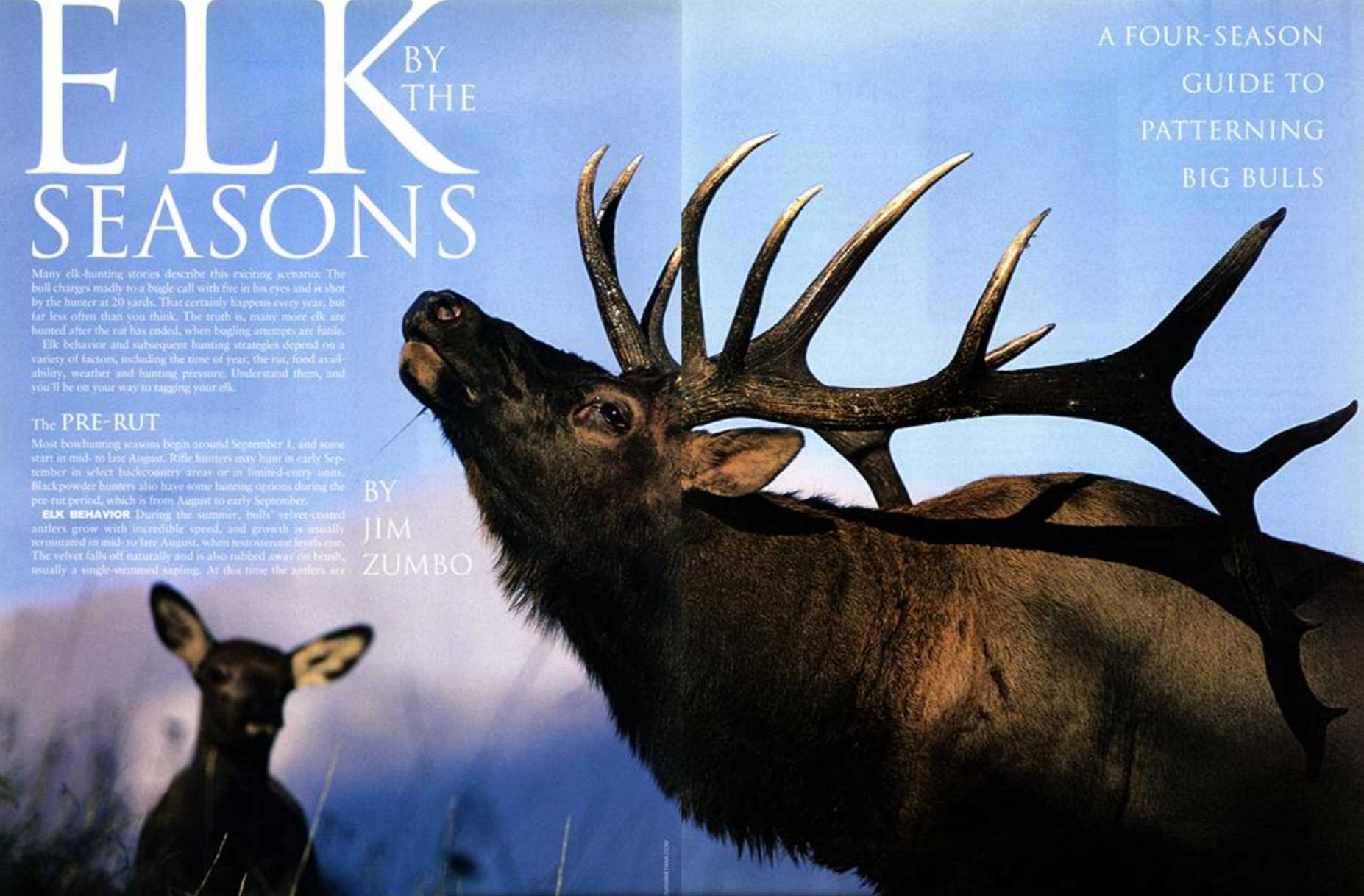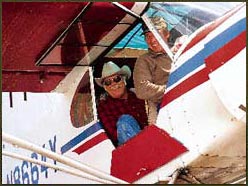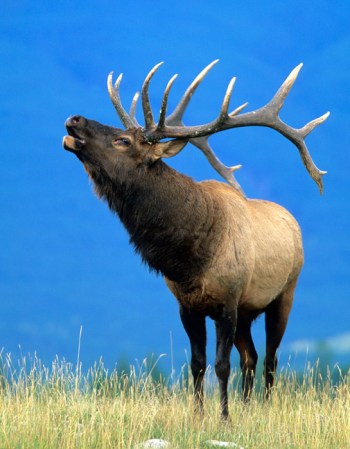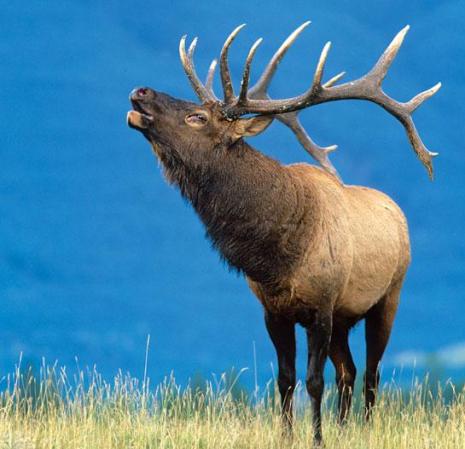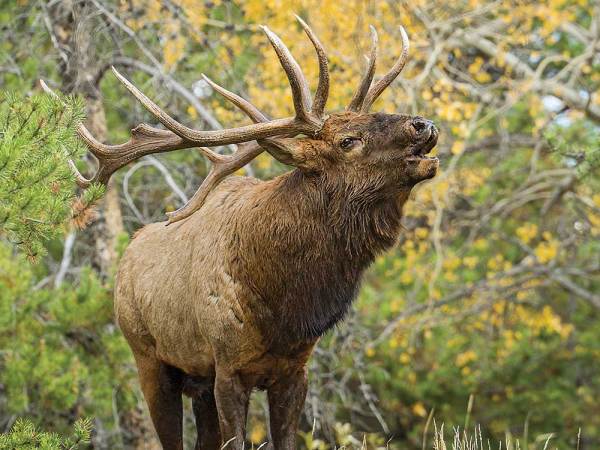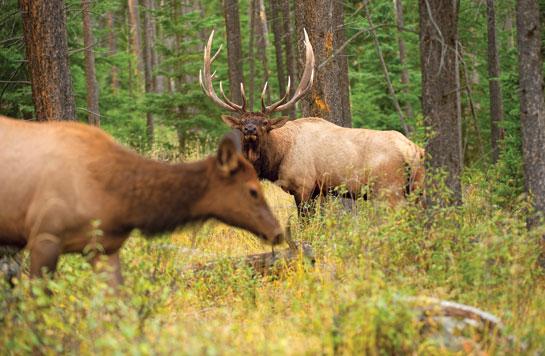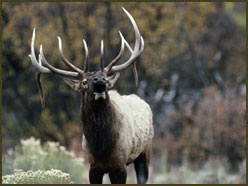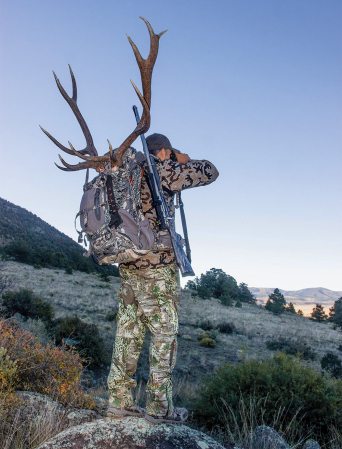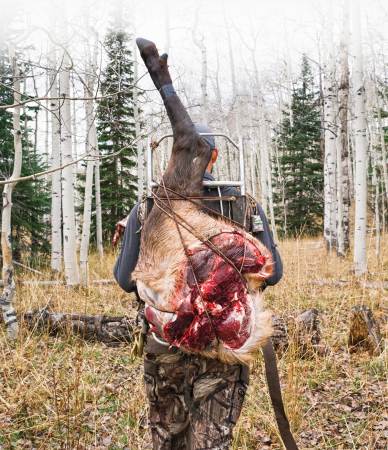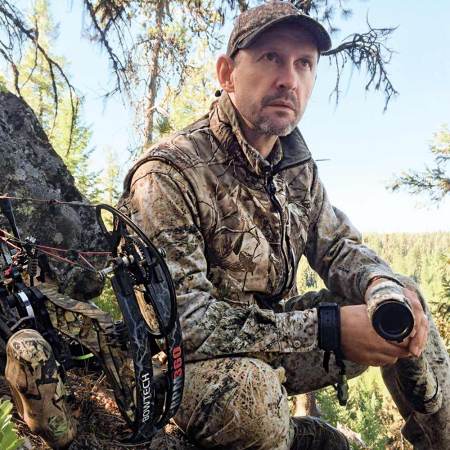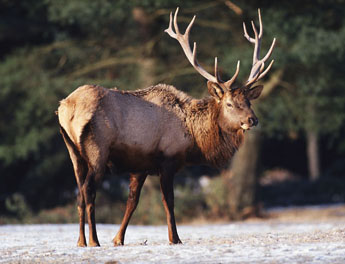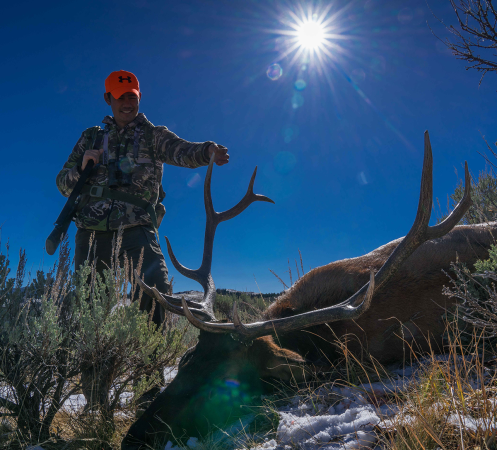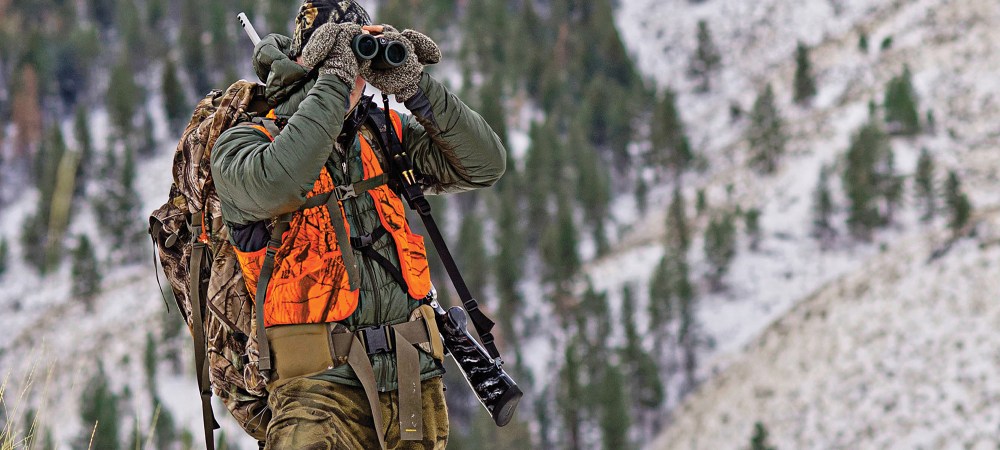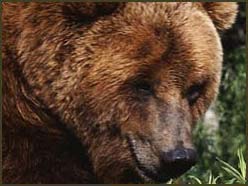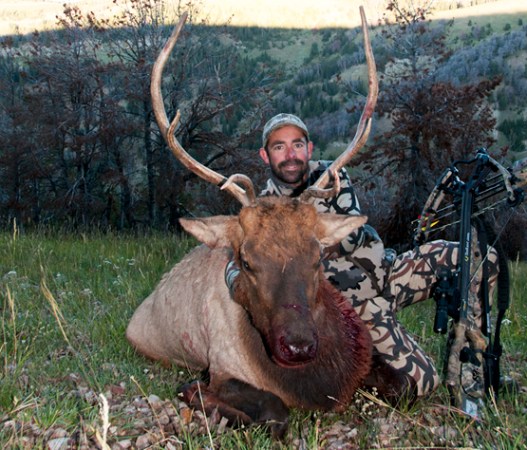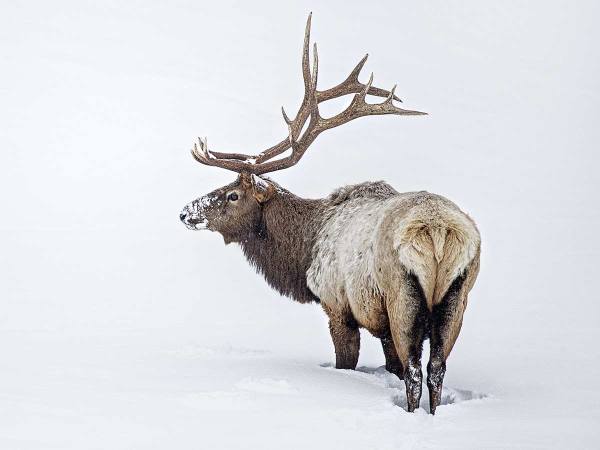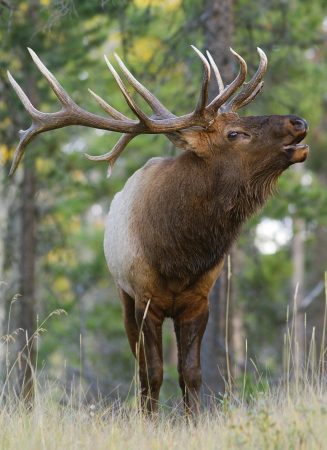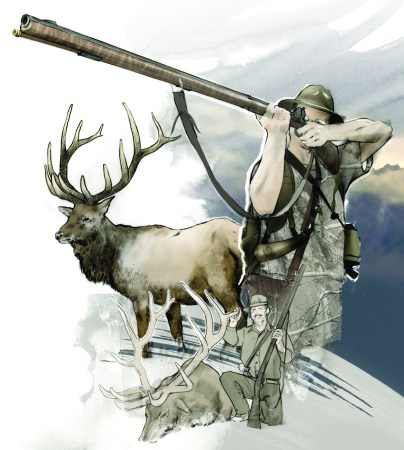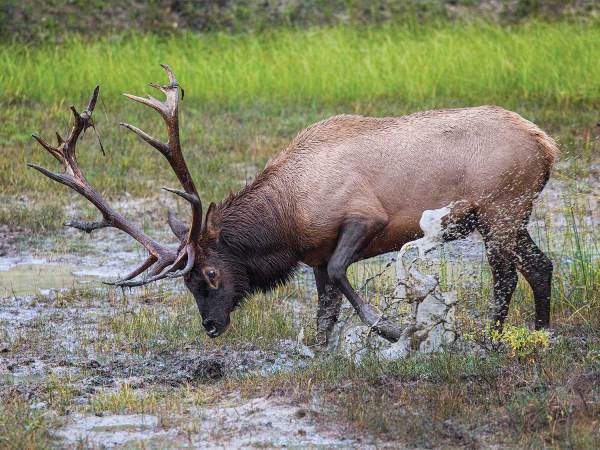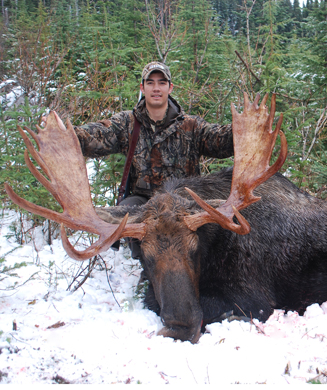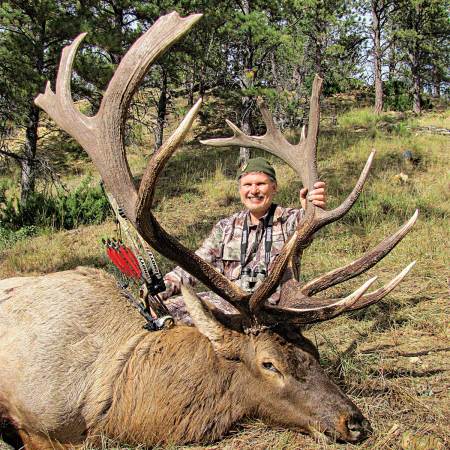Many elk-hunting stories describe this exciting scenario: The bull charges madly to a bugle call with fire in his eyes and is shot by the hunter at 20 yards. That certainly happens every year, but far less often than you think. The truth is, many more elk are hunted after the rut has ended, when bugling attempts are futile.
Elk behavior and subsequent hunting strategies depend on a variety of factors, including the time of year, the rut, food availability, weather and hunting pressure. Understand them, and you’ll be on your way to tagging your elk.
The PRE-RUT
Most bowhunting seasons begin around September 1, and some start in mid-to late August. Rifle hunters may hunt in early September in select backcountry areas or in limited-entry units. Blackpowder hunters also have some hunting options during the pre-rut period, which is from August to early September.
Elk Behavior: During the summer, bulls’ velvet-coated antlers grow with incredible speed, and growth is usually terminated in mid-to late August, when testosterone levels rise. The velvet falls off naturally and is also rubbed away on brush, usually a single-stemmed sapling. At this time the antlers are bloody, but they quickly turn white. More rubbing produces mahogany, tan and brown hues, caused by staining from contact with vegetation.
Bulls are sociable much of the year, living in bachelor herds. But as late August approaches, they separate and begin the process of gathering as many cows as possible. These harems will be jealously guarded by the herd bull for the duration of the rut. This cow-gathering activity may be well along by late August but typically picks up as September progresses. Vocalization increases, with more bulls sounding off as the rut approaches–the peak is generally considered to be the last two weeks of September.
Hunting Strategies: In late August and early September, bugling may not be effective. The days are long and hot, and elk retreat to cool hideouts in the timber. Because of the heat, they’ll often travel from bedding to feeding areas in the night or at the very end of shooting light, when it’s cooler. In arid areas where there are few streams and ponds, such as in parts of Arizona, New Mexico and Utah, elk may head to water before they feed in the afternoon. Look for hidden water holes away from well-traveled roads and trails, and watch them until the end of legal shooting hours.
Elk are fond of wallows in the heat of the summer, often frolicking in them late in the afternoon. Look for wallows around marshes and beaver dams and wherever you see lush green vegetation in the timber, signifying a wet spot. Wallows may also be in and around high-country meadows. If the water in a wallow is muddy, elk are using it. If wallows aren’t present, set up on a trail in late afternoon between the timber and a meadow where you’ve found fresh elk sign. Consider the wind when you select a stand location. Try a bugle call occasionally, as well as a cow call. You might interest a bull who is looking to build an early harem.
THE RUT
The peak of the rut varies with elevation and latitude, but generally it coincides with the first day of fall (September 23 this year). Bow seasons are in full swing in most states, and rifle and blackpowder hunters can pursue elk in special draw units and in some wilderness areas. The rut typically begins in early September and runs into the first week of October or later, when rifle hunts begin in a few states.
Elk Behavior: The early stages of the rut can be a wild time in the woods. Bulls are crazed, thinking only about breeding cows. To this end, bulls challenge each other for rights to cows by bluffing or by outright battles in which slashing antlers determine the victor. The loser rapidly retreats, but if he isn’t quick enough he might be killed.
A herd bull seldom eats or sleeps. He spends most of the day and night guarding his precious harem, running off lesser bulls or dueling with bigger animals. As each cow comes into estrus, the bull pursues her until she’s ready to stand for him. When she’s bred, the bull then turns his attention to other cows that are ready to come into estrus. Solo or satellite bulls have no cows, and spend all their time trying to sneak into a harem or find a cow or two of their own.
Hunting Strategies: This is magic time in elk country, when calling is at its best. Be in the woods long before first light, and listen for bugling bulls. Get away from roads and well-used trails, since elk are wary of humans in high-traffic areas. Penetrate as deeply as you can in the timber. Bulls may be silent if you call from far away, but they come unglued when you get into their backyard. Keep moving until you find sign such as freshly rubbed trees or hear elk vocalizing. If a bull answers your bugle call, quickly set up for a shot. In the timber, an elk may sound like he’s half a mile away. Don’t be surprised if he shows in a few seconds; he was probably closer than you thought.
Use a cow call frequently. A herd bull may shun a bugle call, moving his cows away. He wants to breed them all, not fight another challenger, but he might run in for a look at the cow caller. Ditto for solo bulls who are looking for cows. They’re far more likely to come to a cow call than a bugle call. If you’re hunting where there’s heavy hunting pressure, bulls may be call-shy, refusing to vocalize or respond to calls. Try listening at night. Bulls are active in the dark, and often do much bugling then. If you hear one, try to get a general idea where he is, and then head there before shooting light. Don’t call until you’re close to where you heard him. Before making a bugle call, try some soft cow chirps for 15 or 20 minutes. If you get no response, try a bugle call.
TRANSITION TIME
When the rut is over, bulls are no longer interested in breeding and maintaining harems. Bulls slowly leave cows and start joining up with other bulls. Coincidentally, most general rifle seasons start now, and hunting pressure drastically alters elk behavior. Animals react to the presence of humans in the woods and make the transition from breeding to survival. This transition period generally occurs in the month of October.
Elk Behavior: The onset of rifle season drives elk into deep timber away from roads and causes them to become nocturnal where human pressure is heavy. With cold weather coming on, forage loses its nutritional qualities, and animals often must find new sources and feed for longer periods. This is especially true of dominant bulls that have lost considerable weight during the rut. If the weather remains warm, elk are even more elusive, staying in the timber all day. They may never exit the forest until long after shooting hours. Some large bulls may retreat to lairs and hang out by themselves, remaining there as long as there is adequate food and water. As the season continues, hunting pressure will drive elk to locate shelter where they feel secure and undisturbed.
Hunting Strategies: This is the toughest time in the elk woods. In places where there are crowds of hunters on public land, get as far off the road as you can and look for elk from a high ridge or other elevated vantage point. Be at this spot in the dark, long before daybreak. Glass for elk as soon as you can see, concentrating your efforts in meadows, clear-cuts and old burns where elk normally feed in the night. If you see animals in the distance and can’t get to them before they head for the timber, carefully mark their location and set up on that feeding area in late afternoon. If the animals haven’t been disturbed from their day beds by you or other hunters, they’re likely to exit the forest where they entered.
During the day, elk will bed where they feel secure. In mountainous country, look for them in the upper contours, from the ridgeline to about a quarter of the way down the slope. Elk prefer thickets and blowdowns, especially where dense spruce trees grow. Blow your cow call occasionally if you’re making noise in the brush. Elk will hear your movements and the call will put them at ease, allowing you to move closer. The key to taking an elk at this time is deep penetration in the woods, as well as smart hunting. Stay out there all day, and be alert to other hunters moving elk around.
LATE SEASON
Snow is inevitable in elk country and is usually the factor that triggers migration, although lately several years of mild weather have minimized elk movement. The late season is from November on, but some states have already closed their general rifle seasons.
The later you hunt, the better the chance of snow. There are some outstanding late hunts adjacent to national parks where elk migrate out and onto land available to hunters. These are limited-entry hunts, requiring a lottery draw for a tag.
Elk Behavior: Elk country typically includes a vast area, from very high elevations to the lowlands. When snow piles deep in the upper reaches, animals have no choice but to migrate down, since their food sources are covered with snow. Elk begin gathering together in large herds, remaining in those groups throughout the winter. When they migrate, they tend to use the same routes year after year. In some areas, elk may remain on fairly high windswept ridges where the wind constantly blows the snow away, baring enough forage for the animals to sustain themselves. Where snow is deep in feeding areas, elk may be exposed far longer than usual in the open. It takes longer to paw away snow and find sufficient forage, especially in cold temperatures when elk need plenty of extra calories. Snow and wind have little effect on elk, unless it’s a driving blizzard with gale-force winds. These are tough animals, capable of surviving severe weather, although extended and bitterly cold winters may cause some mortality.
Hunting Strategies: If snow is in the equation, tracking is an effective way to hunt elk. You can find tracks by hiking and looking for fresh prints, but be aware that elk can walk a dozen or more miles a day if they’re headed to winter range. You may never catch up. Far better to cut tracks from animals moving to and from feeding and bedding areas.
In very cold temperatures, elk may linger longer in clearings. Don’t quit glassing until well after legal shooting hours begin. If you have a bull tag and see plenty of cows but no bulls, leave the area and hunt higher, hiking slowly and glassing. Bulls are often in bachelor groups by now and often hang out in higher elevations than cows.
Reading Elk Sign
Knowing when to read sign is as important as actually reading it. Elk have a large home range, and if they’re pressured by hunters or moving because of impending winter weather, it will be a waste of time to look for sign. If animals aren’t disturbed, scouting for sign will indeed be a valuable effort.
It’s not impossible to hear a bull bugling during the late season. If you do, there’s a cow in estrus that he’s interested in. Sometimes a young cow may not be bred during the rut, but will come back in heat later in the year. Don’t bother with calling; it will probably fail. Instead, stalk slowly toward the bull and try to spot him by using his vocalizations as a guide.
Feeding areas are always prime places to find elk. Check meadows, often called “parks,” for signs of freshly browsed grass, as well as droppings. Clear-cuts and old burns also have forage preferred by elk. If hunting pressure is heavy, animals may be nocturnal, or nearly so. Elk may be moving to and from the shelter of timber at the edge of darkness. In that case, even active feeding areas may be impossible to hunt. Keep looking for new spots, especially smaller meadows that have more timber close by, giving spooky animals a heightened sense of security.
If you find a fresh rub, pay attention. Rubs are typically made on saplings 1 to 3 inches in diameter; the tree typically dies since its bark is often slashed away completely around its trunk. A rub made the previous year is easy to spot, since the dead foliage will be rust-colored. If you find old rubs, chances are good you’ll find fresh ones in the vicinity as well. Rubs are made during the September rut. If you see them in October or November, you can assume the bull is still around, since rubs are typically made in the middle of a bull’s home range.
How to Play the Wind
You can almost win money by betting that the prevailing wind in Western elk country will come from the west (see A). When it does, a still-hunter obviously wants the wind in his face–so he’ll walk from east to west, right? It’s not that simple. Mountain thermals have betrayed countless hunters; these wind currents relate to elevation. During the cool hours of late afternoon, during the evening, and early in the morning, thermals blow downslope (see B). As the day heats up, the thermals reverse and the winds then blow upslope (see C). But don’t take this to the bank. Compounding the problem are erratic winds that blow from every direction. I’ve seen breezes blow from all four directions in less than a minute’s time.
If you have the conventional winds and thermals in place, hike uphill early in the morning when the thermals are blowing down toward you. They’ll usually remain that way until midmorning unless it’s unusually hot; in that case the thermals will reverse earlier. In the afternoon, plan your return downslope when the wind is still blowing uphill, but never leave so early that you’ll miss the last few minutes of shooting light.
If erratic winds are blowing from every direction, don’t give up. Most people don’t shoot elk in camp. In the case of severe winds during bitterly cold weather, look for elk on leeward slopes where they’re offered some protection. That doesn’t mean you won’t find animals smack in the thick of it. In fact, elk commonly feed on windswept ridges because the snow is blown away and forage is easier to obtain.
Making the Call
A Louder Tube Call During the rut, no hunter’s daypack is complete without a tube bugle call. Knight & Hale tweaked the conventional design to create the Mega Tube Elk Call (left); it has lots of volume and an easier-to-replace diaphragm. ($14.99; www.knightandhale.com)
Two in One The Lost Herd Cow/Calf call (model KH815, below, far left) from Knight & Hale combines two single-reed calls. One side produces the high-pitched whine of a cow elk; the other emits the ultra-high-pitched call of a calf. Though we found it easy to master, we recommend practicing far away from anyone you wish to stay on speaking terms with–the calf call can out-whine the most vociferous three-year-old. ($9.99; www.knightandhale.com)
No Hands The Bandit Elk Call from Lohman (far right) is the first hands-free cow call. It pivots on its strap to stay out of the way. The call adjusts for different tones. ($11.99; www.lohmangamecalls.com)
Originally published in the August 2003 issue of Outdoor Life
